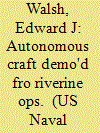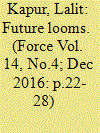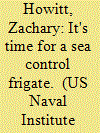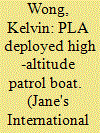|
|
|
Sort Order |
|
|
|
Items / Page
|
|
|
|
|
|
|
| Srl | Item |
| 1 |
ID:
130071


|
|
|
|
|
| Publication |
2014.
|
| Summary/Abstract |
Swiftships competes in global markets for smaller naval ships. The company has delivered 13 120-foot coastal patrol boats to the Iraqi navy under a 15-ship contract and has a long-term agreement with the Egyptian navy to co-produce 25-foot patrol boats in Egypt. It also has built ships to support offshore drilling operations for U.S. and international oil and natural-gas companies.
|
|
|
|
|
|
|
|
|
|
|
|
|
|
|
|
| 2 |
ID:
150687


|
|
|
| 3 |
ID:
130066


|
|
|
|
|
| Publication |
2014.
|
| Summary/Abstract |
A vessel based on the national security cutter could offer significant benefits to the Navy.
W hile O liver Hazard Perry- class frigates are not the only platforms you would want for a serious confrontation, they are great independent-deployers and effective at a multitude of missions such as escort operations and antisubmarine warfare (ASW). As the Navy decommissions the last 15 frigates, soon to be joined by 21 Ticonderoga- class cruisers, we will call on our existing hulls to support their ongoing missions. There is little doubt the littoral combat ship (LCS) fills some of this void, but even the top brass seem to agree that it's ineffective in a high-endurance, blue-water setting.
In January, a report from the Pentagon described a plan to cut the amount of LCSs from 52 to 32 ships, and in a leaked classified memo, Commander of Naval Surface Forces Vice Admiral Tom Copeman called for a new type of multi-mission ship. 1 Many envision a new combatant ship that incorporates air- and missile- defense radar and an electromagnetic railgun. While it is imperative that the Navy build these types of ships, a multibillion-dollar warship juggernaut is simply unnecessary when a new, cost-effective frigate could effectively accomplish the same missions.
Of the many potential frigate designs, Huntington Ingalls Industries offers one derived from its successful national security cutter (NSC) hull dubbed the "patrol frigate," originally intended and modeled for international navies. At first, it may seem preposterous to paint a Coast Guard cutter gray and call it a warship. In the July 2013 issue of Proceedings , Norman Polar opined that more frigates were needed, but was quick to dismiss a patrol frigate as a viable option. He claimed it "lacked growth potential and service life, as well as certain military features." 2 But tweaking the NSC could turn it into a viable candidate that meets the Navy's needs.
|
|
|
|
|
|
|
|
|
|
|
|
|
|
|
|
| 4 |
ID:
098914


|
|
|
| 5 |
ID:
131717


|
|
|
|
|
| Publication |
2014.
|
| Summary/Abstract |
A people's liberation army (PLA) border patrol unit based in the Nyingchi Military sub district has brought into operation a new patrol vessels specifically design for high altitude activities.
|
|
|
|
|
|
|
|
|
|
|
|
|
|
|
|
| 6 |
ID:
130068


|
|
|
|
|
| Publication |
2014.
|
| Summary/Abstract |
The Independence -class littoral combat ship (LCS) has a fundamentally different design from any other ship in the Navy. Understanding how its design affects propulsion, sea-keeping, and reactions to external forces is critical to understanding how to drive it effectively, efficiently, and safely.
The Independence -class LCS is propelled by four steerable water jets (WJs) that have independent drive trains. The two outboard WJs, driven by motor turbine union 20-cylinder main propulsion diesel engines (MPDE) rated at 12,200 horse power (HP) each, have the most impact on low-speed precision maneuvering due to their position off centerline. The two inner WJs, used for high-speed operations and restricted maneuvering situations, are driven by LM2500 gas turbine engines, each with speeds up to 29,500 HP. The ship develops thrust as water is drawn through intakes under the hull, travels through each WJ tunnel, and is driven at high speed through the WJ by an impeller.
Attached to each WJ is a hydraulically actuated reversing plate commonly referred to as a "bucket," which controls the amount of water directed forward or aft. When the ship's control console (SCC) indicates zero percent bucket, roughly one-third of the water is directed astern and two-thirds are directed forward and down, causing the applied longitudinal forces to cancel out. Even at this "zero-thrust" point, the impellers are still turning at idle speed, an important consideration for the effects of engine wash on surrounding vessels and structures.
|
|
|
|
|
|
|
|
|
|
|
|
|
|
|
|
|
|
|
|
|